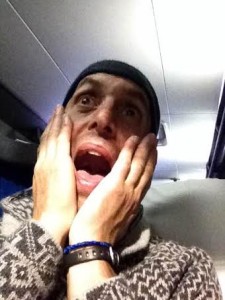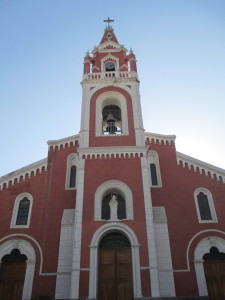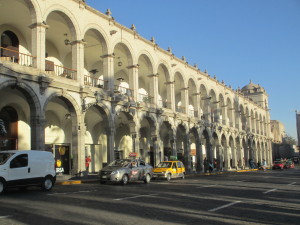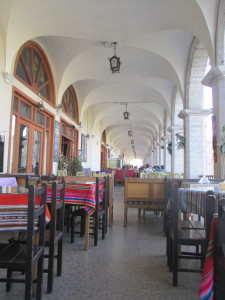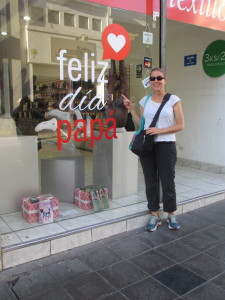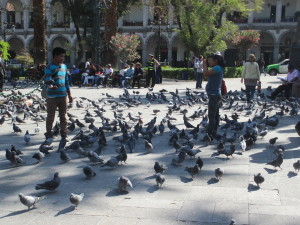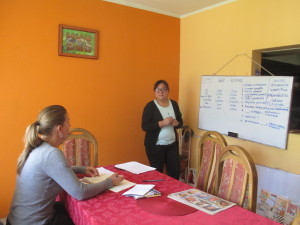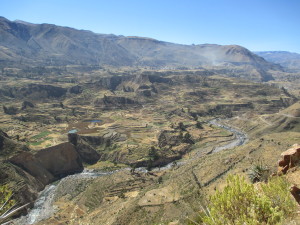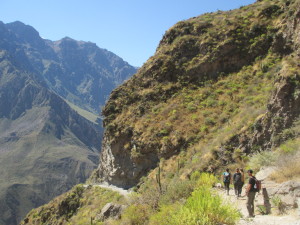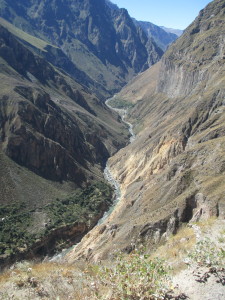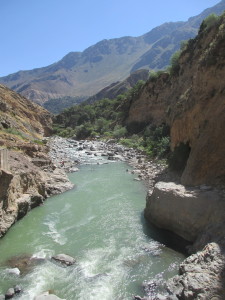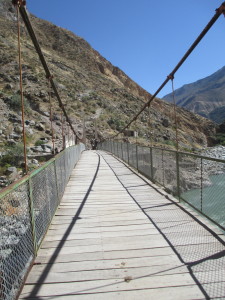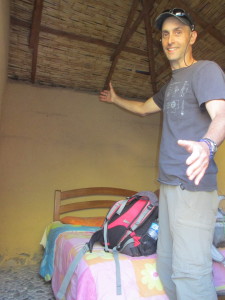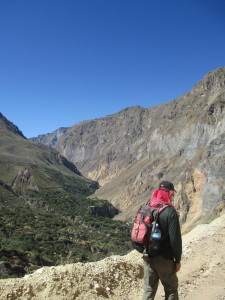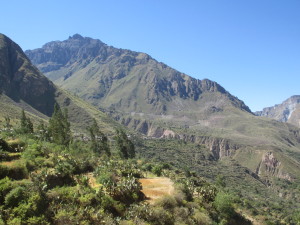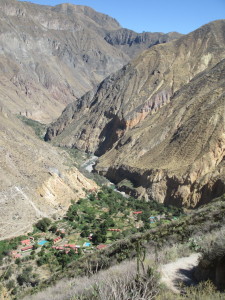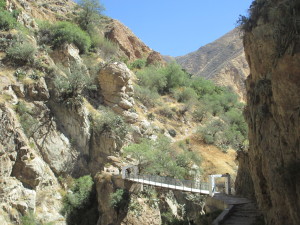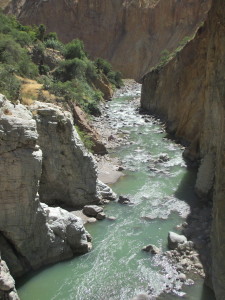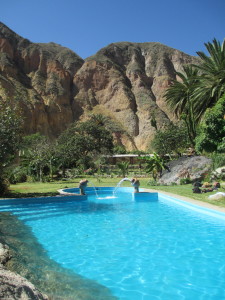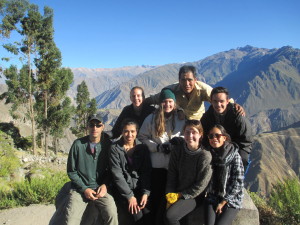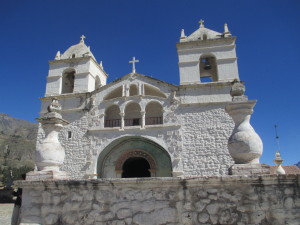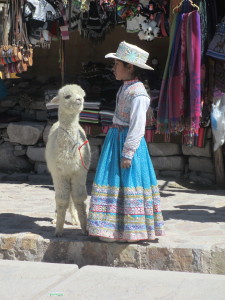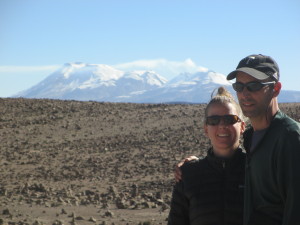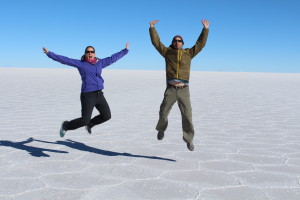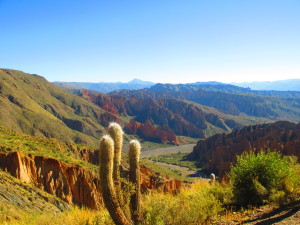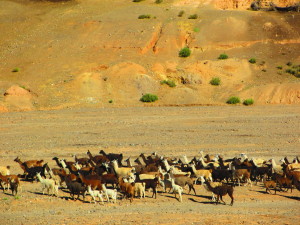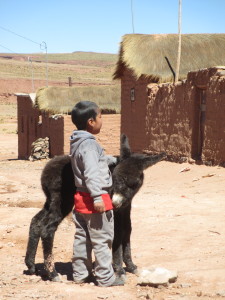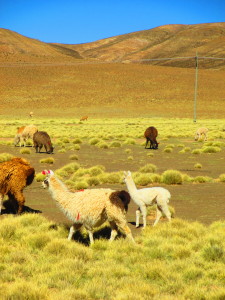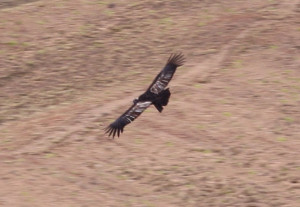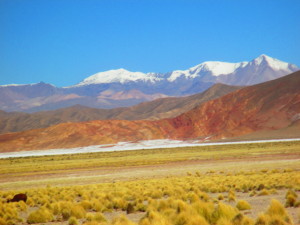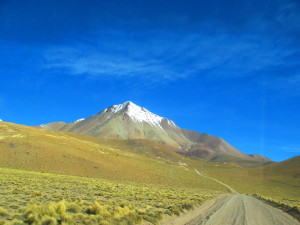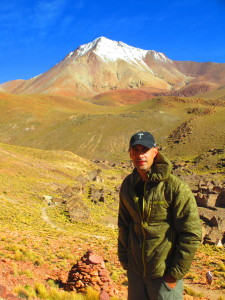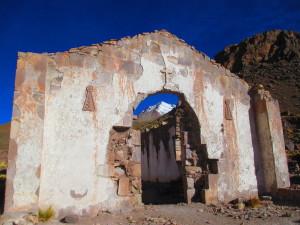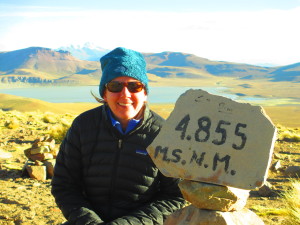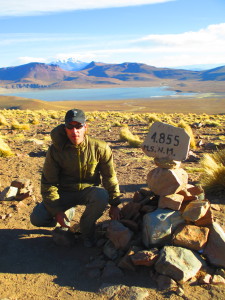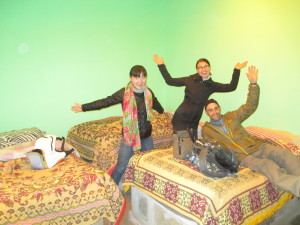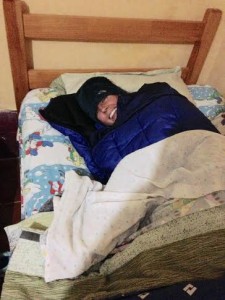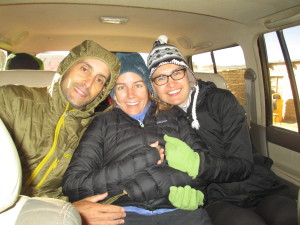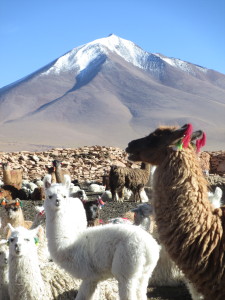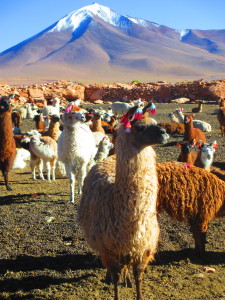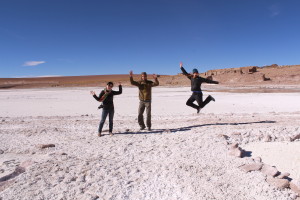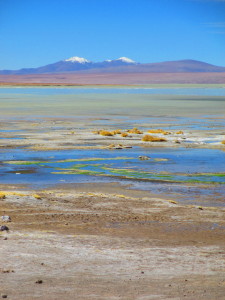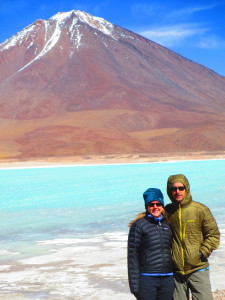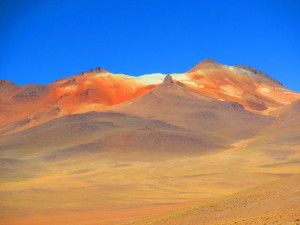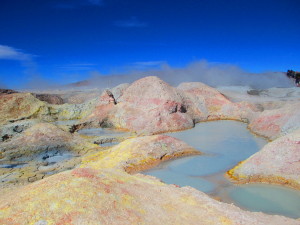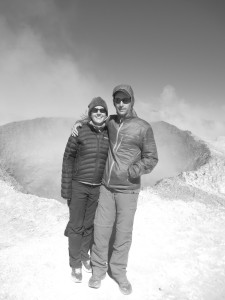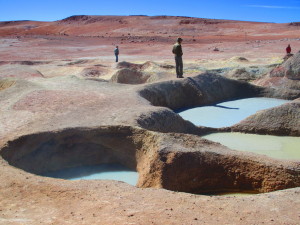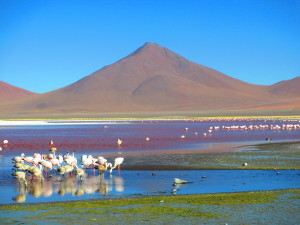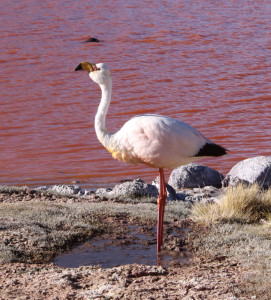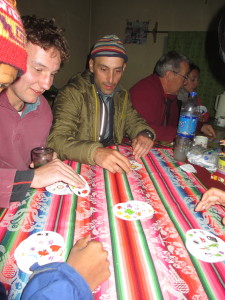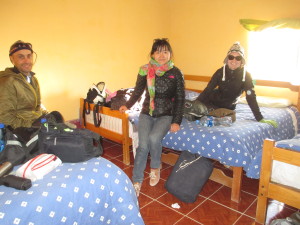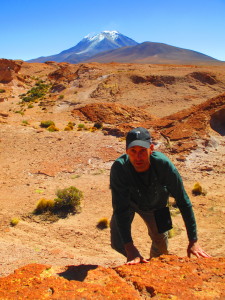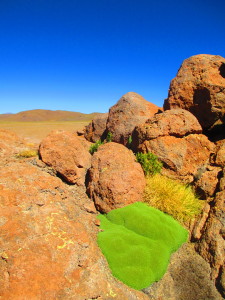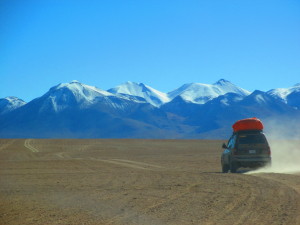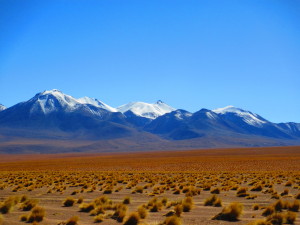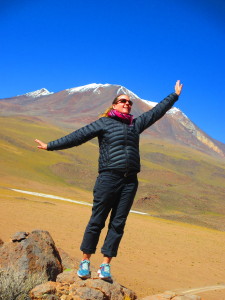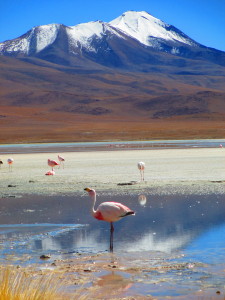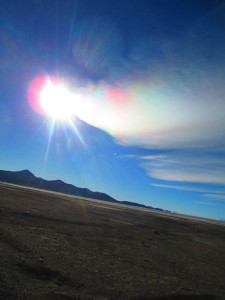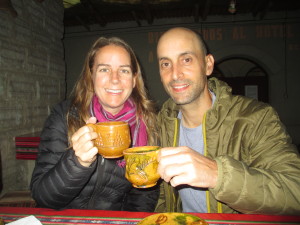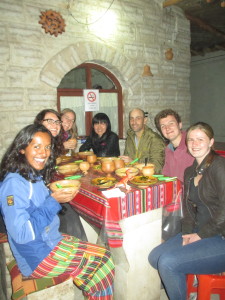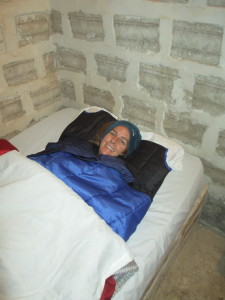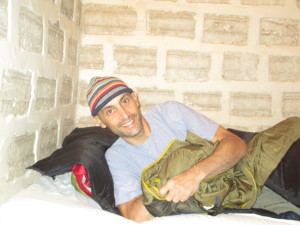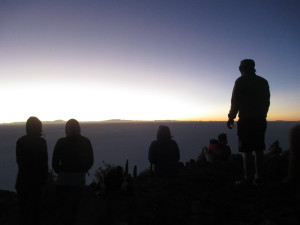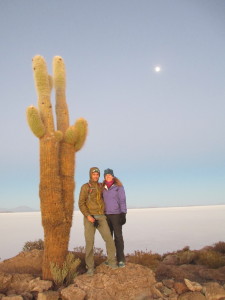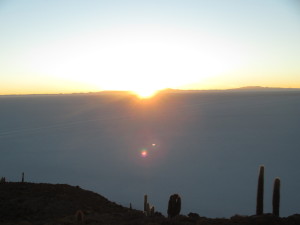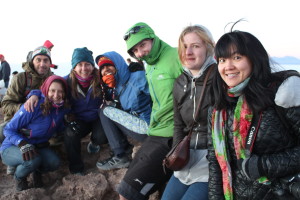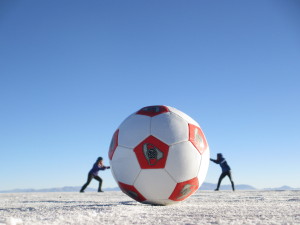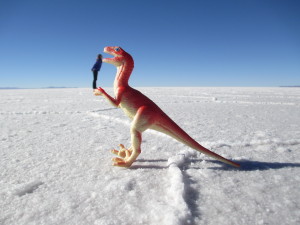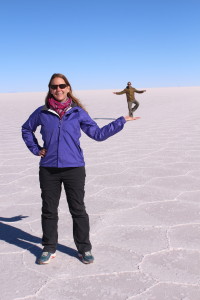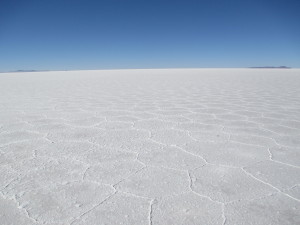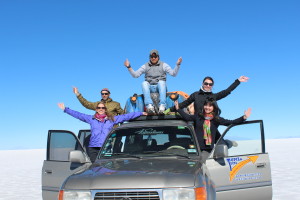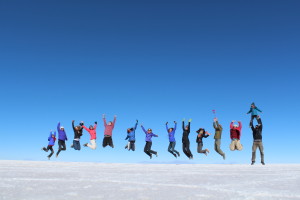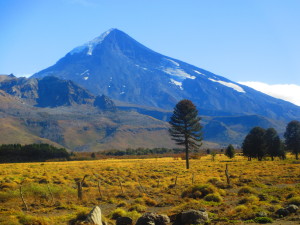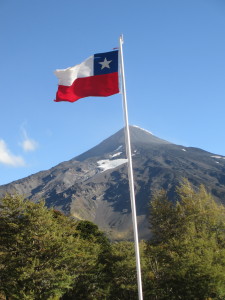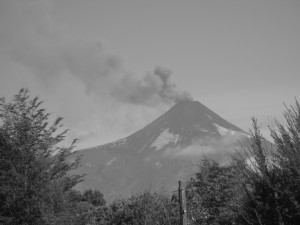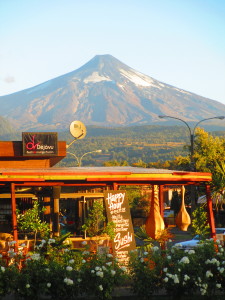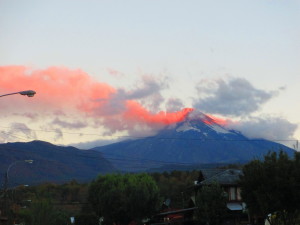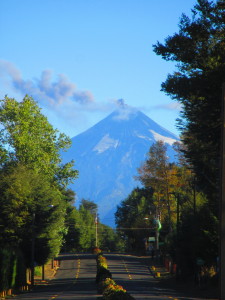Say what?! We have to take a 10 hour night bus south from Cusco to Arequipa?
I’m pleased to report that despite waking up with a thin coating of ice on the inside of the windows (no wonder I was so cold all night!), the trip went pretty smoothly. For me, that is. Harry, on the other hand, dealt with an irritable gut for most of the way. Luckily he made it without incident (can you imagine the horror?).
Arequipa: The White City
We were looking forward to settling down in Arequipa for almost three weeks. While we loved our stay in sweet Cusco, it was time to get away from the hoards of tourists and lose ourselves in a city for a while. We were ready to dump out our backpacks and call Arequipa home.
A city in southern Peru, Arequipa is surrounded by three volcanoes that dominate its landscape. El Misti, the largest one, sits right on the edge of town, treeless and brown with a little snow frosting on top. Except for December and January, it rarely rains here as evidenced by the dry, barren landscape surrounding the area. Arequipa boasts the nickname “white city” because many of the buildings were built from sillar, a white volcanic stone. Truth be told, we thought the buildings were actually more like a dingy gray than white. There were also a freakish number of pigeons in the main plaza and we were surprised and a little grossed out by the number of parents who tried to get them to land on the heads of their children.
We stayed at a B+B this time around and the owner and his staff became like family. They took good care of us and while they spoke English, we were encouraged to speak Spanish as much as possible. Arequipenos are really proud of their city and consider it to be the best place in all of Peru. We had many great conversations about life around the world.
Fun fact: in Arequipa, lunch is the biggest meal of the day and it always starts out with a bowl of soup…. and there is actually a specific soup schedule that all restaurants and households follow. On Mondays you’ll eat caldo blanco, on Tuesdays you’ll eat menestron, and so on. It’s a tradition they’re very proud of. Soup’s on!
Evil Peruvian Gut Monsters
It finally happened. We got sick, really, really sick. For four days we were fighting over the bathroom. We’re pretty sure the lettuce we ate was the culprit. Whatever it was, it was bad. Really, really bad. Rest assured we don’t have any pictures of that dark and depressing time.
World Cup + Copa Cup
To say that soccer in South America is a big deal would be the understatement of the year. The Copa Cup, a tournament between the South American countries, took place in the month of June. All of the games, regardless of which countries were playing, were watched in every bar, restaurant and home. It was fun to watch the games and talk to everyone about “last night’s game”. Peru was a big contender and advanced to the semifinals where they sadly lost to Chile. Chile, the host country, ended up beating Argentina in the finals. We were cheering for Argentina.
The only downside to the Copa Cup was that the women’s World Cup was held during the same period of time. This made watching games nearly impossible since men’s soccer took priority, of course. I didn’t find one person (man or woman) in Peru who knew that the women’s World Cup even existed. We managed to catch the first five of the USA games either by a live-stream or by going to TGIFridays (shhh! Don’t tell anyone). We normally make it a habit to avoid all American stores, but for my women we made an exception! (We saw the finals in Lima… that’s the next post).
Spanish School
The main reason we stayed in Arequipa for so long was to take two weeks of Spanish classes. This time we upped the ante by taking classes five days a week for four hours a day. I really liked my teacher and finally felt like I found someone who understood my style of learning. We had a lot of fun in class together.
Colca Canyon: 3-Day, 2-Night Adventure
Before we started Spanish classes we wanted to explore Colca Canyon and the surrounding valley. Peruvian novelist Mario Vargas Llosa described Colca as “The Valley of Wonders”. The area proudly showcases massive volcanoes, narrow gorges, desert landscape, pre-Inca terraced agricultural slopes and remote traditional villages. The Colca River, one of the sources of the Amazon River, slices through the massive gorge.
Twice as deep as the Grand Canyon at 11,150 feet, Colca Canyon is part of a volcanic mountain range more than 60 miles long. We spent a few days at the Grand Canyon this past October and we were excited to explore another impressive natural wonder.
Planning our 4-day journey to Machu Picchu took a lot of time and energy, so I simply asked our hotel to just book our trip for us. I was burnt out on doing research and dealing with logistics. The thought of handing the reigns over to someone else felt like a really good idea for a change. We paid our money, packed one backpack to share between us and went to bed early because we were being picked up at 4:00 AM.
Day #1
The ridiculously early start was necessary because access to the trailhead was six hours away at Cabanaconde. Also, the condors that inhabit the area are most active in the morning so we had to leave early to catch them in action. Once the sun rose we all woke surrounded by spectacular scenery.
The sun was already beaming with intensity by the time we started hiking down into the canyon. The trail was steep and slippery with dry scree. The three miles we hiked straight down were BRUTAL on our knees. Our quads took quite a beating as well. The combination of the steep, rocky path and tired legs had me tripping several times, toppling forward like a drunk turtle with my pack on. Even all the younger hikers complained about the non-stop stress on their knees. Our eyes on the Colca River prize down below, we chatted with the others in our group and made our way down to the water.
Three hours later we arrived at the river, red-faced, sweaty and covered with dust. We walked over the suspension bridge, hiked up a steep incline and then walked another mile paralleling the river until we reached San Juan de Chucco, our home for the night. We were promised “basic” accommodations and that’s what we got. We didn’t mind not having heat or electricity, but clean sheets would have been nice.
Day #2
The next day we hiked for three hours across a section of the canyon. The lateral movement felt good on our legs and gave us a chance to look around and observe our surroundings. One side of the canyon was a sheer rock wall, dry and inhospitable. The other side was thick with desert vegetation. There are 14 traditional villages/pueblos throughout the valley and we hiked through several that day. It was eye-opening to see how people live in such remote and desolate conditions. We were fascinated by the practical farming techniques, specifically water management. Water was gathered in containers at high elevation, using gravity to disperse it through channels to the crops below.
We spent the second afternoon and night at Sangalle, nicknamed the Oasis, a village located at the base of the gorge. Lush vegetation and natural pools dotted the landscape thanks to the channels of water cascading down from the mountains. While it seemed a contradiction to have such a lush environment in the midst of arid, desert mountains, we didn’t hesitate and jumped right into the cold pool. We spent the remainder of the day hanging out with our five hiking companions, whose average age was 21. As usual we were the elders of our group. We all had a good time together and we especially enjoyed getting to know Asta and Simone from Denmark.
Day #3
We started hiking up the canyon at 5:00 AM in total darkness, our footsteps illuminated only by our headlamps. The hike down was so brutal that we were all pretty much dreading the hike back up. And for good reason because it, too, was BRUTAL! Three miles straight up the side of a dry, dusty and rocky mountain path. We passed one woman who was weeping out loud because the hike was so challenging. There were even a few people who had to ride donkeys to make it to the top. We forged ahead, three hours in all, and felt like champs when we reached the top.
On the way back to Arequipa we made the obligatory stop at one of the small villages where we, once again, didn’t buy anything but walked around and took photos.
The last stop of the day was at a 16,000 foot mountain pass. Here we are with Sabancaya, an active volcano, blowing steam behind us. The air was thin, the view was spectacular and we were feeling very happy and oh so tired. Gracias, Colca Canyon!


